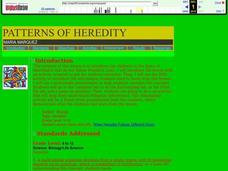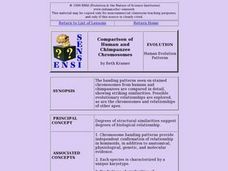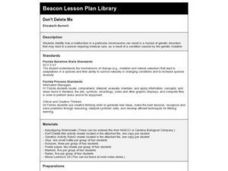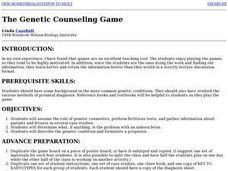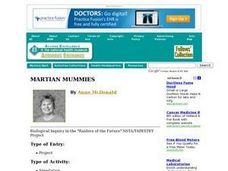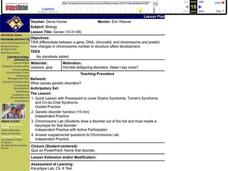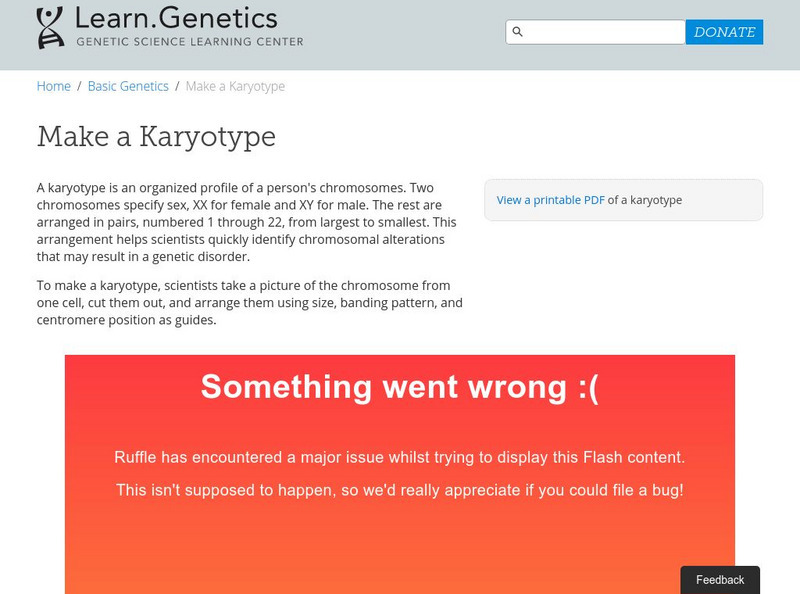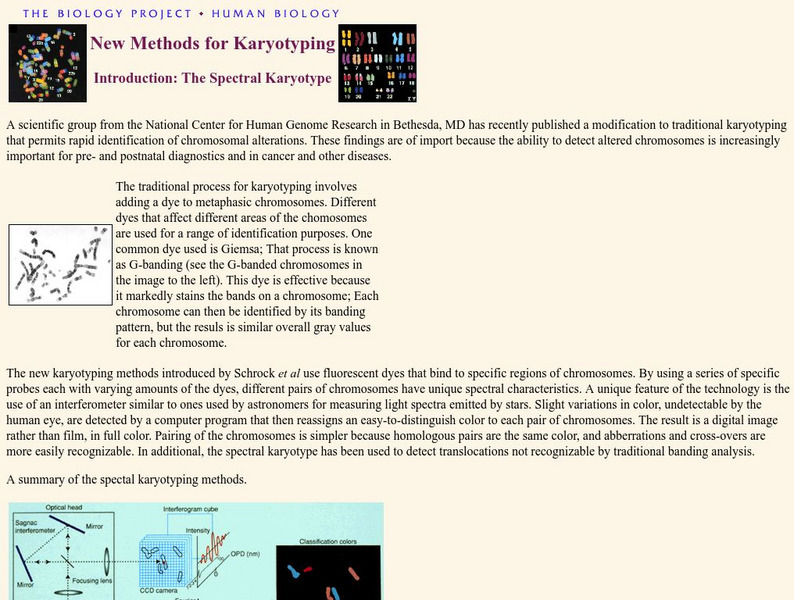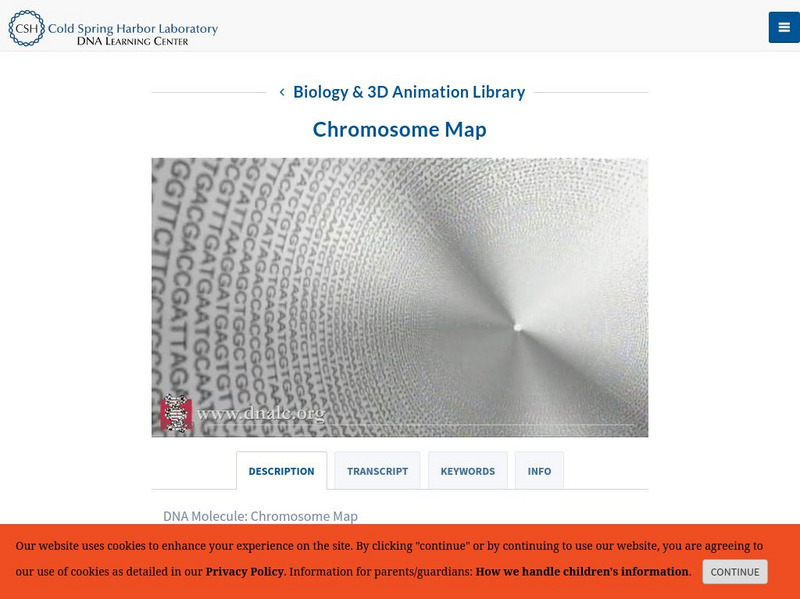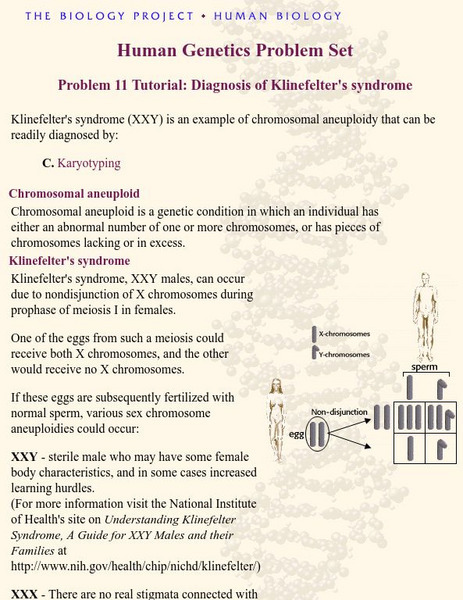Curated OER
Chapter Fourteen Questions: Human Genome
This multiple-choice and short-answer quiz covers chromosomes, genetic disorders, and more. The multiple choice section could work as a pretest, as well.
Curated OER
How Can You Predict the Characteristics of an Unborn Baby?
Learners compare three sets of unlabeled human chromosomes and gather related data, trace chromosomes to pair them, and make observations about them.
Curated OER
Patterns of Heredity
Students describe the differences between incomplete dominance and codominant alleles, and between multiple alleles and polygenic inheritance. They describe how internal and external environments affect gene expression. They then...
Curated OER
Genetics 5 Technology
High schoolers, after studying extraction and gel electrophoresis, recombinant DNA, transgenic organisms, and reproductive cloning, summarize the main concepts in DNA technology. They analyze the applications of DNA: forensics, medicine,...
Curated OER
Modeling Allele Distribution Through Meiosis and Fertilization
The main objective of this activity is to illustrate the variation that results from crossing-over during prophase I of meiosis. Other sources of variation from generation to generation are: (1) independent assortment (223 possible...
Curated OER
Comparison of Human and Chimpanzee Chromosomes
Students actively engage in the careful analysis of chromosome banding patterns and identify examples of inversion in homologous chromosomes.
Curated OER
Don't Delete Me
Fourth graders explore genetic disorders, which can be caused by a malfunction in a particular chromosome and how these can cause genetic mutation.
Curated OER
The Genetic Counseling Game
Learners explore genetics and ethical issues. They siimulate the role of genetic counselors, perform fictitious tests, and gather information about parents and fetuses in case studies. Students describe the condition and formulate a...
Curated OER
Genetics 4 Mutations
Students identify and illustrate how changes in DNA cause mutations and evaluate the significance of these changes. They illustrate a chromosomal mutation such as duplication, deletion, inversion, and translocation.
Curated OER
More on Meiosis
In this meiosis worksheet, students fill in the blank that describes the process of meiosis. Students also draw the process of meiosis.
Curated OER
Who's the Father?
Learners analyze gels to determine parentage in this lesson about scientific evidence, investigation, and DNA concepts. The lesson includes a pre-activity worksheet, a final individual assessment, and student handouts for in-class...
Curated OER
Martian Mummies
Students participate in "Raiders of the Future", a role play about futuristic scientists sending a spaceship to Mars for research and exploration. They collect geological samples for analysis, discover the ruins of an ancient...
Curated OER
The Chromosome Connection
Young scholars evaluate the degree of chromosome similarity and difference between humans and apes. Students infer about the relationship between a human and ape based on similarities found.
Curated OER
Genes
High schoolers discuss the difference between a gene, DNA, chromatid, and chromosome. They predict how changes in chromosome number or structure affect development. Students discuss what causes genetic disorders. They view a...
University of Arizona
Biology Project: Karyotyping Activity
If you want an interactive way to practice karyotyping, this is it. There are three patient histories and karyotypes to use in diagnosing human genetic disorders. There is enough information on comparing chromosomes to get you started.
University of Arizona
Biology Project: Karyotyping Activity
Try your hand at matching chromosomes to complete the karyotype in this simulation. Simulation contains karyotyping activity for three different patients and students can explore whether those patients have any genetic disorders.
University of Utah
University of Utah: Genetics Learning Center: learn.genetics: Make a Karyotype
Drag and match the chromosome pairs to organize this human karyotype profile.
University of Arizona
The Biology Project: Human Biology: New Methods for Karyotyping
Read about the findings from the scientific group from the National Center for Human Genome Research, which published a modification to traditional karyotyping that permits rapid identification of chromosomal alterations.
University of Washington
Uwmc Cytogenetics Laboratory: Cytogenetics Gallery
This site opens with an excellent introduction to Cytogenetics. Explore this site to learn about chromosomes, human karyotypes and more.
University of Utah
University of Utah: Learning Center: Learn Genetics: Using Karyotypes to Predict
Follow a series of chromosome problem scenarios to learn about several genetic disorders. Test your knowledge with a quiz at the end of the exercise.
National Health Museum
Access Excellence: Human Chromosomes
This map from Access Excellence shows human chromosome pairs. The site includes a short description of chromosome structure, staining of chromosomes and karyotypes.
Cold Spring Harbor Laboratory
Dolan Dna Learning Center: Dna Molecule: Chromosome Map
Find out about the chromosome karyotype and how that identifies a human as a human. [0:46]
University of Arizona
Ua: Diagnosis of Klinefelter's Syndrome
Brief tutorial dealing with Klinefelter's diagnosis. Provides illustration of nondisjunction and Klinefelter's karyotype. Information provided regarding other sex chromosome aneuploidies.
Other popular searches
- Karyotype Activity
- Karyotype Charts
- Karyotypes and Pedigrees
- Genetics Karyotype
- Human Chromosome Karyotype
- Karyotype Lab
- Biology Karyotype
- Karyotype Puzzle
- Mutations and Karyotype
- Karyotype Presentation
- Chromosome Karyotype
- Lesson on Karyotypes




